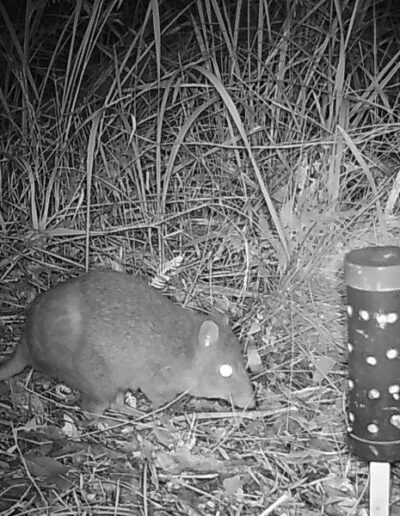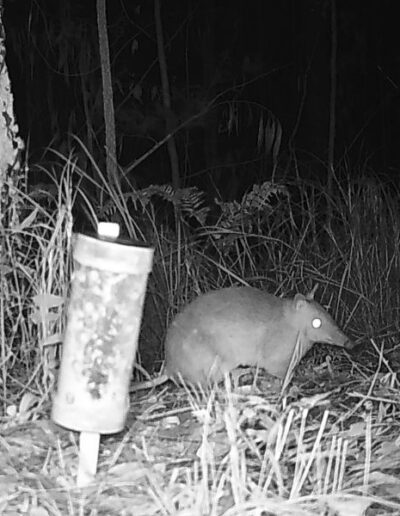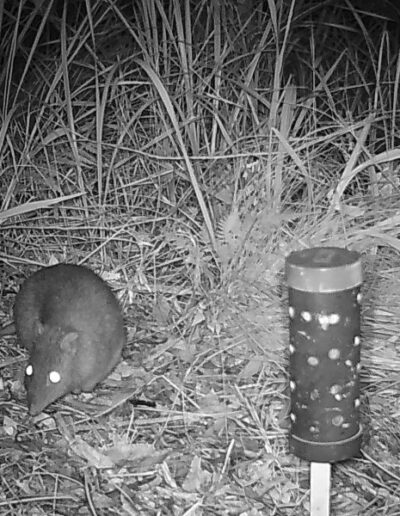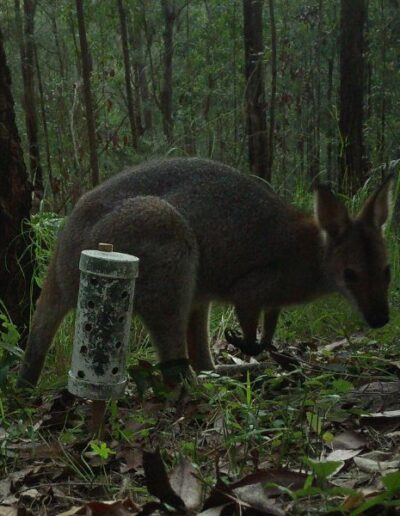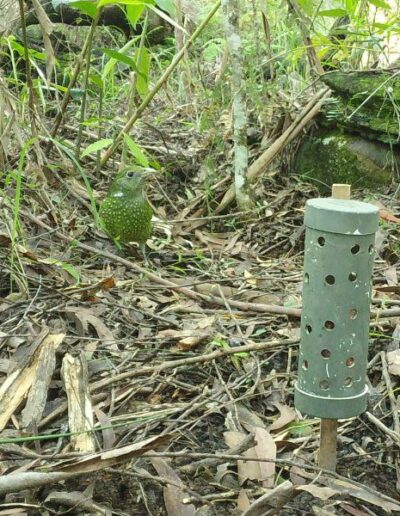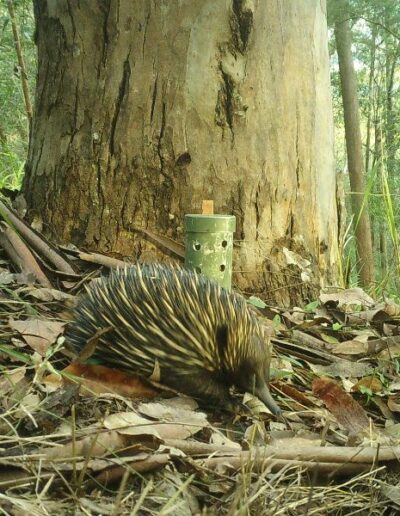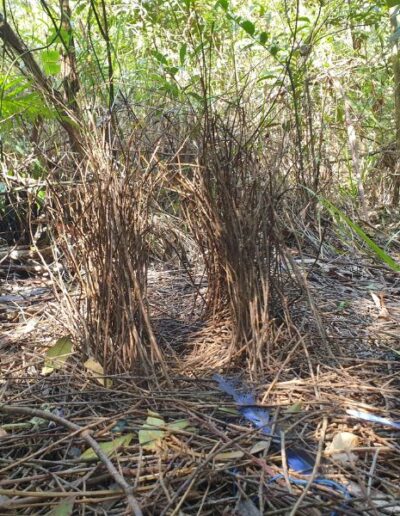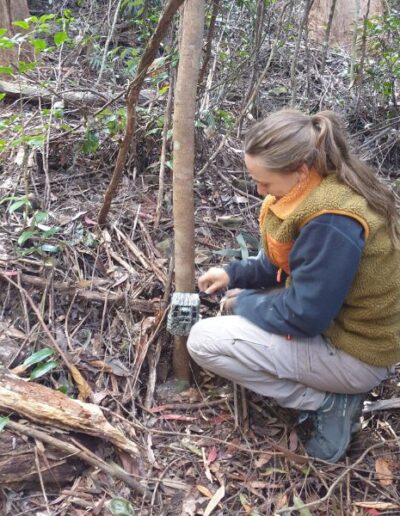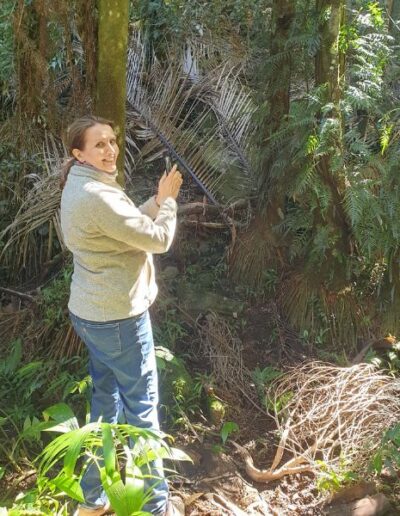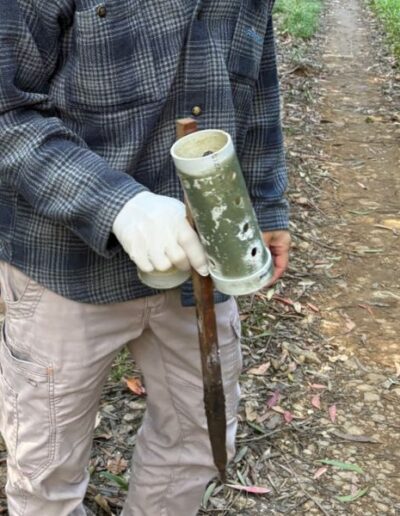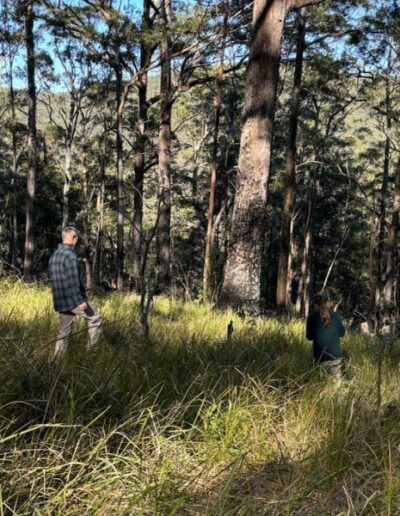
13 August 2024 | By Wenda Shurety
As a communications officer for the Wildlife Preservation Society of Queensland (Wildlife Queensland), my typical day involves working behind a desk, creating text and graphics to inform the public about our conservation work. But today, I had the unique privilege of trading my keyboard for hiking boots to experience life as an ecologist. I was eager to see the rainforest in action rather than through reports and photos.
Searching for evidence of spotted-tailed and northern quolls
Wildlife Queensland Projects Manager, Matt Cecil, and Project Officer, Maaike Hofman, planned a day collecting wildlife cameras and remaining scent lures in the beautiful Bellthorpe National Park and kindly invited me to tag along. This was part of a Quoll Seekers Network project, funded by the Queensland Government Community Sustainability Action grant program, determining whether spotted-tailed quolls (Dasyurus maculatus) and northern quolls (Dasyurus hallucatus) still reside in the Sunshine Coast Hinterland area. Read more about the project here.
The Sunshine Coast Hinterland area historically served as a thriving habitat for both quoll species. Today, however, the spotted-tailed quoll, a species once a common sight in coastal South East Queensland, is now rarely seen. The northern quoll has not been recorded in the area since the 1990s.
Sombre discovery and wildlife greeting
The day started early, with the sky still dark as I woke up, ready for the two-hour drive to the park. During the drive, we made an unfortunate discovery — a freshly killed red-necked wallaby by the roadside. Maaike quickly checked its pouch for a joey, but sadly, the little pinkie had not survived.
As we neared the park entrance, we were greeted by a burst of wildlife activity. Whiptail wallabies darted along the road, and swamp wallabies peered at us from the bushes. I was excited to discover what wildlife we’d find on the cameras. What if a camera captured the elusive spotted-tailed quoll?
Cameras and stinky scent lure retrieval
Stepping out of the car, I first noticed the chill in the air. Despite my four layers and scarf, Matt seemed unfazed in his Wildlife Queensland T-shirt. Our first task was to collect wildlife cameras from a forest dominated by blackbutt trees (Eucalyptus pilularis).
To reach the cameras, we waded through long grass, sparking my curiosity about the presence of snakes. Matt reassured me that he hadn’t seen a venomous snake while crashing around in the bush during his 20-year career in conservation.
The infra-red cameras were strapped to young trees, each accompanied by a scent lure placed 1.5m away. The lure consists of a canister filled with festering chicken necks designed to attract the carnivorous quoll species. While Maaike sorted out the cameras, Matt had the delightful task of removing the stinking bait. I was relieved I wasn’t asked to help.
Our next few stops were in a dense rainforest area packed with vines, ferns, and towering trees with thick trunks. It was stunning. The only sounds were a burbling creek, and the occasional calls of whip birds echoed in the distance, adding to the enchantment.
A highlight was spotting a massive birdwing butterfly vine in the wild just off the road during our travels. Hopefully, it will be covered in Richmond birdwing butterfly larvae by summer.
Planning camera placement
As we walked, Matt and Maaike explained the meticulous planning for placing the cameras. The cameras are strategically positioned in different terrains, from ridge tops and gullies to sparse forests and rocky cliffs. Each location is chosen based on distance from fire trails, vegetation types, and animal trails, ensuring the best chance of capturing spotted-tailed or northern quoll activity.
One of the most memorable sights during my adventure was a male bowerbird bower. These birds are known for their intricate bowers decorated with blue objects, and this one was no exception. Feeling sympathetic towards the bird’s meagre collection, Matt left a blue souvenir to add to its treasures.
Camera visitors
Reviewing the footage from the cameras, we found that a variety of animals had investigated the scent lure. Recorded wildlife species included short-beaked echidna, green catbird, swamp wallaby, red-necked wallaby, long-nosed bandicoot, northern brown bandicoot, koala, kangaroo, rufous bettong, red fox, red deer, and long-nosed potoroos. Unfortunately, neither the spotted-tail nor the northern quoll were recorded.
However, the Wildlife Queensland ecology team is not giving up on finding a quoll. Wildlife cameras will be installed in four more large, protected areas throughout the Sunshine Coast Hinterland. We’ll keep you posted.
Spending a day as an ecologist was an eye-opening and enriching experience. Stepping out from behind the computer screen and into the wilds of Queensland gave me a deeper appreciation for the hands-on efforts that drive our conservation goals. It was a day well spent and one I won’t soon forget.
Related information and articles
- Quoll seeking in South East Queensland continues.
- Download the Landholders guide: Saving the Spotted tailed Quoll.
- Learn more about Wildlife Queensland’s Quoll Seekers Network.
- Report a quoll sighting.
- Subscribe to our eBulletin Talking Wildlife to learn more about your local wildlife and receive updates on Wildlife Queensland’s latest news, offers and events.

